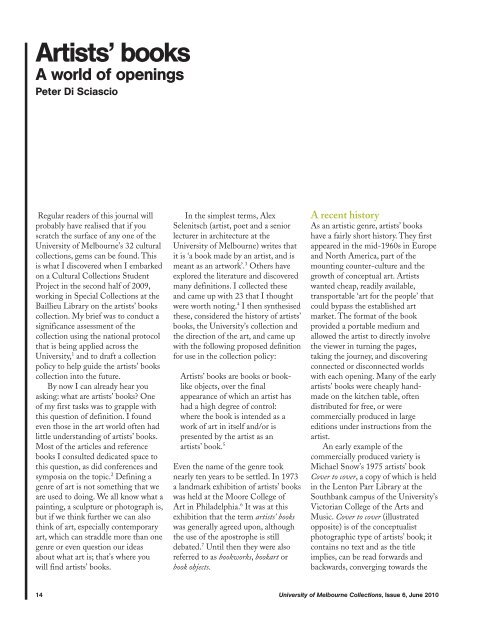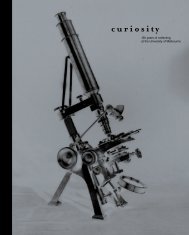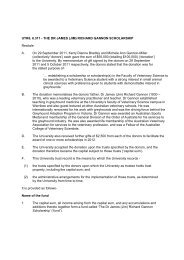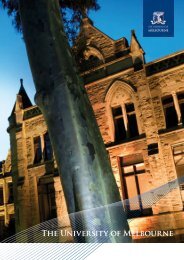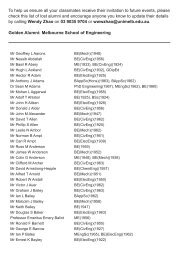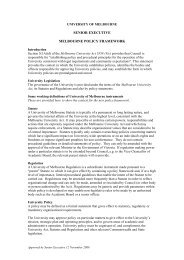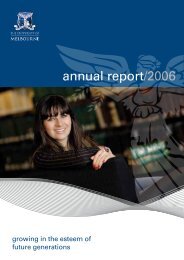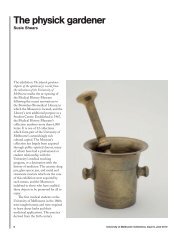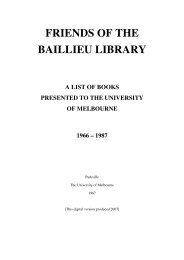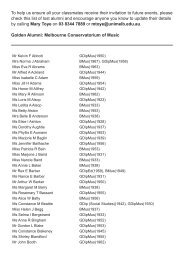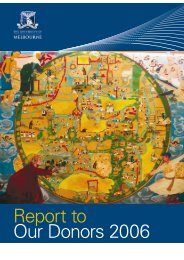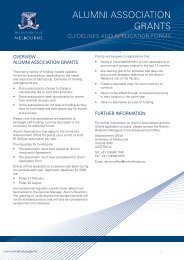COLLECTIONS - University of Melbourne
COLLECTIONS - University of Melbourne
COLLECTIONS - University of Melbourne
Create successful ePaper yourself
Turn your PDF publications into a flip-book with our unique Google optimized e-Paper software.
Artists’ books<br />
A world <strong>of</strong> openings<br />
Peter Di Sciascio<br />
Regular readers <strong>of</strong> this journal will<br />
probably have realised that if you<br />
scratch the surface <strong>of</strong> any one <strong>of</strong> the<br />
<strong>University</strong> <strong>of</strong> <strong>Melbourne</strong>’s 32 cultural<br />
collections, gems can be found. This<br />
is what I discovered when I embarked<br />
on a Cultural Collections Student<br />
Project in the second half <strong>of</strong> 2009,<br />
working in Special Collections at the<br />
Baillieu Library on the artists’ books<br />
collection. My brief was to conduct a<br />
significance assessment <strong>of</strong> the<br />
collection using the national protocol<br />
that is being applied across the<br />
<strong>University</strong>, 1 and to draft a collection<br />
policy to help guide the artists’ books<br />
collection into the future.<br />
By now I can already hear you<br />
asking: what are artists’ books? One<br />
<strong>of</strong> my first tasks was to grapple with<br />
this question <strong>of</strong> definition. I found<br />
even those in the art world <strong>of</strong>ten had<br />
little understanding <strong>of</strong> artists’ books.<br />
Most <strong>of</strong> the articles and reference<br />
books I consulted dedicated space to<br />
this question, as did conferences and<br />
symposia on the topic. 2 Defining a<br />
genre <strong>of</strong> art is not something that we<br />
are used to doing. We all know what a<br />
painting, a sculpture or photograph is,<br />
but if we think further we can also<br />
think <strong>of</strong> art, especially contemporary<br />
art, which can straddle more than one<br />
genre or even question our ideas<br />
about what art is; that’s where you<br />
will find artists’ books.<br />
In the simplest terms, Alex<br />
Selenitsch (artist, poet and a senior<br />
lecturer in architecture at the<br />
<strong>University</strong> <strong>of</strong> <strong>Melbourne</strong>) writes that<br />
it is ‘a book made by an artist, and is<br />
meant as an artwork’. 3 Others have<br />
explored the literature and discovered<br />
many definitions. I collected these<br />
and came up with 23 that I thought<br />
were worth noting. 4 I then synthesised<br />
these, considered the history <strong>of</strong> artists’<br />
books, the <strong>University</strong>’s collection and<br />
the direction <strong>of</strong> the art, and came up<br />
with the following proposed definition<br />
for use in the collection policy:<br />
Artists’ books are books or booklike<br />
objects, over the final<br />
appearance <strong>of</strong> which an artist has<br />
had a high degree <strong>of</strong> control:<br />
where the book is intended as a<br />
work <strong>of</strong> art in itself and/or is<br />
presented by the artist as an<br />
artists’ book. 5<br />
Even the name <strong>of</strong> the genre took<br />
nearly ten years to be settled. In 1973<br />
a landmark exhibition <strong>of</strong> artists’ books<br />
was held at the Moore College <strong>of</strong><br />
Art in Philadelphia. 6 It was at this<br />
exhibition that the term artists’ books<br />
was generally agreed upon, although<br />
the use <strong>of</strong> the apostrophe is still<br />
debated. 7 Until then they were also<br />
referred to as bookworks, bookart or<br />
book objects.<br />
A recent history<br />
As an artistic genre, artists’ books<br />
have a fairly short history. They first<br />
appeared in the mid-1960s in Europe<br />
and North America, part <strong>of</strong> the<br />
mounting counter-culture and the<br />
growth <strong>of</strong> conceptual art. Artists<br />
wanted cheap, readily available,<br />
transportable ‘art for the people’ that<br />
could bypass the established art<br />
market. The format <strong>of</strong> the book<br />
provided a portable medium and<br />
allowed the artist to directly involve<br />
the viewer in turning the pages,<br />
taking the journey, and discovering<br />
connected or disconnected worlds<br />
with each opening. Many <strong>of</strong> the early<br />
artists’ books were cheaply handmade<br />
on the kitchen table, <strong>of</strong>ten<br />
distributed for free, or were<br />
commercially produced in large<br />
editions under instructions from the<br />
artist.<br />
An early example <strong>of</strong> the<br />
commercially produced variety is<br />
Michael Snow’s 1975 artists’ book<br />
Cover to cover, a copy <strong>of</strong> which is held<br />
in the Lenton Parr Library at the<br />
Southbank campus <strong>of</strong> the <strong>University</strong>’s<br />
Victorian College <strong>of</strong> the Arts and<br />
Music. Cover to cover (illustrated<br />
opposite) is <strong>of</strong> the conceptualist<br />
photographic type <strong>of</strong> artists’ book; it<br />
contains no text and as the title<br />
implies, can be read forwards and<br />
backwards, converging towards the<br />
14<br />
<strong>University</strong> <strong>of</strong> <strong>Melbourne</strong> Collections, Issue 6, June 2010


